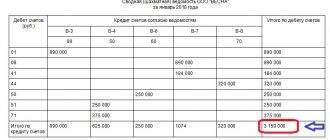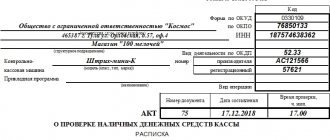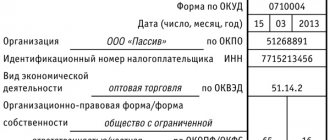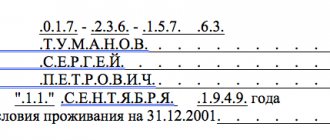By law, all organizations must provide their employees with special clothing, as it is necessary to protect them from unwanted environmental influences while performing their duties.
Accounting for workwear in 1C 8.3 Accounting 3.0 is carried out in accordance with Order of the Ministry of Labor No. 997n. In this step-by-step instructions, we will look in detail at the entire process of writing off workwear in 1C with different useful lives due to the fact that accounting standards for them differ.
Purchasing workwear
First of all, you must reflect in the program the purchase of the workwear itself. To do this, go to the “Purchases” section and create a new document “Receipts (acts, invoices)”.
Fill out the header of the document, indicating the standard details of the supplier, your organization and where the purchased goods will be listed.
Our team provides consulting, configuration and implementation services for 1C. You can contact us by phone +7 499 350 29 00 . Services and prices can be seen at the link. We will be happy to help you!
In our case, the organization purchases rubber boots, a blue cotton robe and cotton gloves. As you can see, in the figure above, all item items have an accounting account of 10.10. 1C 8.3 filled it out automatically.
If this does not happen for you, go to the card of the corresponding item item and make sure that “Workwear” is set as the item type.
We will also check the rules for determining the accounting accounts for the rubber boots we buy. Her priority score is 10.10.
We will not fill out anything else in this document. Now you can carry it out and check the correctness of the formation of movements.
Accounting for receipt of special clothing
Working clothes, special footwear or other personal protective equipment in an organization can be purchased in different ways; they can be made independently, purchased from other persons, received by the founders as a contribution to the authorized capital or by other legal means.
All workwear owned by the organization, under economic control or operational management is accounted for accounting purposes at actual cost, i.e. the amount of actual costs of production or acquisition calculated in the manner prescribed for accounting for inventories. If the workwear used in the organization does not belong to it, then it is recorded on off-balance sheet accounts at the cost specified in the contract or at the cost specified by the owner.
Before transferring into production or operation, workwear belonging to the organization, as well as workwear under operational management or economic control, is accounted for as part of current assets on account 10 “Materials”. Account 10, for the purpose of accounting for special clothing, must have a subaccount “Special equipment and special clothing in warehouse.”
In the case of manufacturing workwear on your own, costs are recorded in the “Main Production” or “Auxiliary Production” accounts. Upon completion of work on the production of workwear, a certificate of completion of work in the established form is drawn up.
The primary accounting documents when transferring workwear manufactured by our own departments to the warehouse are the requirement-invoice form M-11 or invoice form M-15, approved by the State Statistics Committee of the Russian Federation.
The requirement-invoice form M-11 or invoice form M-15 is drawn up in triplicate. One copy remains with the manufacturer, the other is transferred to the accounting department for the receipt of manufactured workwear, the third, together with the workwear, is transferred to a warehouse or other storage location. The posting of special clothing to the warehouse is completed with a receipt order of form M-4. In some cases, workwear can be transferred directly to production for use, bypassing the warehouse. But this does not exempt you from filling out warehouse and accounting documentation. In this case, incoming and outgoing warehouse documents and incoming documents in the department where the special clothing was received for use are filled out. The division takes place among those workers who are entitled to special clothing.
Organizations, in addition to the basic forms of primary documentation, can use their own forms of documents to reflect the movement of material assets, in this case, workwear, but their own forms must have all the mandatory fields provided for by the Federal Law “On Accounting”.
For accounting purposes at the enterprise, to reflect the transfer of special clothing of its own production to the warehouse, a posting is made to the debit of the “Materials” account, the subaccount “Special equipment and special clothing in the warehouse” and to the credit of the production cost accounts in the amount of actual costs incurred for its production. The actual cost of manufactured workwear is determined in accordance with the established procedures for calculating the cost of the relevant types of products. The loan may have an account “Main production” or an account “Auxiliary production”.
https://youtu.be/CEFehEPCDJ0
Transfer into operation
After the fact of receipt of workwear was reflected in 1C 8.3, it began to be listed in the main warehouse as account 10.10. Now you can issue it directly to the organization’s employees. The document “Transfer of materials for operation” is used for this purpose. You can create it based on the workwear receipt we just created.
1C Accounting automatically filled in all possible fields, but suppose that we want to put into operation only 10 rubber boots. In the tabular part we indicate physical. person - Abramov Gennady Sergeevich. It is he who will now be credited with rubber boots.
Pay special attention to filling out the “Purpose of Use” column, which is marked in the image above. It contains an element of a special directory, which indicates the procedure for repaying the cost of special clothing and special equipment.
You can fill out this guide yourself. In our example, the linear method of paying off the cost was chosen. We are going to reflect expenses on account 25.
Assume that the useful life of the rubber boots in this example assignment will be 11 months. In accordance with the law, such workwear can be written off immediately if the period does not exceed 12 months.
After entering all the data, the document can be processed.
Opportunities for accounting for workwear at the enterprise
Most of the automated accounting systems that exist today allow the possibility of integration with existing databases of enterprise employees, for example, data on employee positions and the objects to which they are assigned can, in particular cases, be imported from the database of the 1C system “Personnel Accounting” module .
This eliminates the need to manually enter into the program information about all employees of the enterprise and their positions. Some versions of the 1C Enterprise system have the ability to account for workwear, but accounting capabilities are mainly presented in the area of accounting needs.
Software systems that automate the accounting of workwear at an enterprise allow you to create directories and catalogs containing a list of names of workwear or PPE. At the same time, for each element or set of workwear, you can set parameters such as wear time, select the size and color, and also assign this type of equipment to a specific production unit or facility.
For example, for workers in hot shops, special clothing is provided that is not issued to, say, electricians or high-rise assemblers and vice versa, but at the same time there are universal elements of equipment that can be equipped with all departments of the enterprise, for example, mittens, gloves, socks, caps, etc. Sunglasses. All these points allow us to reflect modern accounting programs.
Automated scientific complexes, as a rule, provide for the possibility of maintaining the entire “life” cycle of workwear:
- receipt at the warehouse (receipt);
- issuance to an employee;
- handing over the issued special clothing by the employee;
- write-off of workwear that has become unusable.
Disposal of workwear
Based on the transfer of materials into operation, this workwear can be written off.
The document was filled out automatically, and all we had to do was change the number of rubber boots to be written off.
After posting the document in the postings, you can verify that all boots in the amount of 10 pieces were written off from the account MTs.02.
An example of accounting entries reflecting the disposal of workwear
| Debit | Credit | Sum | Posting Contents |
| Quantity | |||
| 62.1 | 10.10 | 300 | The transfer of gowns for nurses under contracts providing for the fulfillment of obligations in kind is reflected |
| 1 |
Return from service
Sometimes in practice there are cases when workwear needs to be returned from use. There can be many reasons for this phenomenon, for example, dismissal, sick leave, business trip or transfer of an employee.
A document for the return of their use can be created based on the transfer of materials into operation.
In this case, just like in the previous example, you just need to indicate the quantity. The image below shows an example of the return of one pair of wellington boots.
After posting the document, we see that one pair worth 150 rubles has been written off from account MTs.02. The boots accounting account has changed from 10.11.1 (in service) to 10.10 (in warehouse).
Accounting is a delicate matter
In addition to the main financial costs for personal protective equipment, including seasonal clothing sets, there are additional ones, which are also included in the total amount, which is ultimately indicated as actual. All additional expenses are recorded in a separate column indicating the invoice.
In total, there are “99” debit and credit accounts, each of which plays a significant role, also for writing off issued workwear.
Before using specific examples to consider the main situations and examples of accounting for workwear, it is worth noting that the system for writing off clothing will depend on the service life. All protective equipment with a service life that does not exceed 1 year are written off at the time of transfer to the worker, and equipment with a service life of more than 12 months are considered depreciable materials and are written off gradually in equal parts throughout the entire period of use.
Examples : 1. A manufacturing enterprise purchased materials for personal use by employees. Based on the amount of total costs and the created order for receiving materials, according to form No. M-4, an accounting record of the purchased material and placed in the warehouse was created in the accounting department.
| Accounting for income and expenditure of funds | Action taken | |
| Debit | Credit | |
| 10-10 | 19, 60, 68, 71, 76 | Transfer of materials to the warehouse (indicating the name and quantity) |
Where: 10-10 – crediting of clothes to the warehouse, 19 – added tax to the total price, 60 – funds for payment by suppliers, 68 – funds spent on paying taxes and fees provided for by the Tax Code of the Russian Federation, 71 – funds issued for reporting for certain types of expenses, 76 – accounts receivable and accounts payable.
All this adds up to the total value of the received piece of workwear.
2. Let's give a specific example of crediting clothes to a warehouse from a direct supplier, taking into account the funds spent on delivery and transportation with accrued VAT.
The company purchased workwear in the amount of 78,000 rubles, including VAT; 10% was added to this amount for the transportation of clothing from the manufacturer’s warehouse to the enterprise’s warehouse. The total amount of maximum permissible value for each expenditure is 20%. In accounting, after the completion of the shipment and receipt of materials, a record will be created:
| Accounting for income and expenditure of funds | Sum | Action taken | ||
| Debit | Credit | |||
| 10 | 10-10 | 85 800 | Transferring clothes to the warehouse (78,000+10%) | |
| 10 | 60 | 65 000 | Cost of clothing excluding VAT | |
| 19 | 60 | 13 000 | VAT amount | |
| 10 | 60 | 7 800 | Delivery costs excluding VAT | |
| 19 | 60 | 1 300 | Delivery costs including VAT | |
Where: 10 – fixed assets of the company, 10-10 – materials owned in the warehouse, 19 – taxes calculated on the purchased item, 60 – funds spent on closing debts with contractors and direct suppliers.
3. After completing the registration procedure at the warehouse and checking them, PPE is issued in accordance with the standards specified in the legislation personally to the employee, after which each issued item is recorded in the personal record card of issued workwear and goes into operation status:
| Accounting for income and expenditure of funds | Action taken | |
| Debit | Credit | |
| 10-11 | 10-10 | PPE issued for the use of a worker |
Where: 10-10 – PPE from the warehouse, 10-11 – PPE for personal use, directly at the place of work.
If the period of use of special equipment is less than 1 year, then after issuance, the cost of the equipment is written off in full without additional calculations for each month, indicating only the date of issue and write-off. It is also necessary to indicate the debit and credit, which confirm the validity of the expenses and their type. It is worth remembering that wearing protective clothing outside the workplace is prohibited.
4. Speaking about clothes with a long service life, write-off calculations are carried out for each month of the entire service life. However, if the amount of one item of clothing does not exceed 40,000 rubles, then the Tax Code of the Russian Federation provides for its write-off after commissioning, regardless of the period of actual use. The result is the imposition of time restrictions, which leads to a temporary difference in the period of use. To ensure that the entrepreneur does not have to pay additional tax on freely issued workwear as an item of property, which after being issued to the employee it no longer is, it is necessary to draw up a document for the right to use a temporary tax deferral until the end of its service life and write-off of the item of clothing.
The company purchased protective raincoats costing 8,000 rubles and having a service life of 18 months. Based on the above, we obtain a fixed accounting entry:
| Accounting for income and expenses | Sum | Action taken | |
| Debit | Credit | ||
| 68 | 77 | 1 600 | Tax deferment (8,000*20%) |
| 77 | 68 | 88,89 | Reduction of tax liability ((8,000:18)*20%) And so on monthly, until the last payment of the temporary difference and until the end of the service life |
Where: 68 – tax accounts, 77 – deferred tax payment obligations.
If the received clothing is designated as a fixed asset, then the time difference can be avoided. This provision was provided for by the Ministry of Finance - PBU 6/01, however, it also has a number of disadvantages. The main one, of which we can consider the imposition of property tax, is on all types of personal protective equipment exceeding the cost of 40,000 rubles without the possibility of writing off after transfer for use.
Repayment of cost
We will add one more item to the previously introduced transfer of workwear - “Blue cotton robe” in the amount of 5 pieces. In the purpose of using the robe, we indicate that its useful life will be 18 months, that is, a year and a half.
Repayment of the cost of the robe will be made at the close of the month. In our example, all documents were posted from September 2020. In this regard, the operation we need to pay off the cost of the robe will be carried out at the close of October 2017. A similar scheme is used for depreciation of fixed assets.
Let's look at the transactions that were created by the operation of repaying the cost of workwear and special equipment in October 2020. As shown in the figure below, a write-off was made for the robe in the amount of 97.22 rubles. This amount will be used to repay the value of this position within 18 months.
In accordance with the specified data in the intended use, the calculation turned out as follows:
- 5 (number of bathrobes) * 350 (price of one bathrobe) / 18 (useful life) = 97.22 rubles.
If the employee does not return the workwear
Material liability of the employee
But if the employee does not return (or through his own fault spoils) the workwear, then this actually causes damage to the employer, which will have to be compensated. 238, part 1 art. 243 Labor Code of the Russian Federation. Its size must be determined by the employer based on the cost of the workwear, taking into account the degree of wear and tear on the day the damage was caused (for example, on the date of dismissal of the employee) Articles 246, 247 of the Labor Code of the Russian Federation. In addition, the company must keep records of the issue of workwear. After all, in order to prove the amount of damage, information is needed about the residual value of the workwear on the date of dismissal, about the period of wear of the workwear, about the degree of its suitability at the time of issue (that is, whether the workwear was issued new or used) Appeal ruling of the Krasnoyarsk Regional Court dated 02/09/2015 No. 33-1150/15, A-12.
True, before making a decision on compensation for damage by employees, the employer must follow a certain procedure: conduct an inspection with the help of a specially created commission to find out the causes of the damage, and receive written explanations from the employees. 247 Labor Code of the Russian Federation. And if the amount of damage does not exceed the employee’s average monthly earnings, then the employer, by his own order (usually issued in the form of an order), can withhold it from the salary of the guilty employee, even without his consent. 248 Labor Code of the Russian Federation; Determination of the St. Petersburg City Court dated January 30, 2012 No. 33-1070/2012. Just do not forget that the employee must be familiarized with the order to recover damages under his personal signature.
If the employee does not agree to voluntarily compensate for the damage caused, the amount of which exceeds his average monthly earnings, the employer can demand compensation for damage only through the court. 2 tbsp. 248 Labor Code of the Russian Federation.
Tax consequences for the employer
VAT. If the employee upon dismissal agreed with the employer that he will not return the workwear and at the same time the employer will deduct its cost from the salary, then the ownership of this workwear passes to the employee. Such a transfer of ownership on a paid basis is nothing more than the sale of goods, which is subject to VAT in accordance with the generally established procedure. Letter of the Ministry of Finance dated 07/09/2013 No. 03-07-11/26420. VAT will also have to be charged in case of gratuitous transfer, when the employer does not require compensation from the employee for the residual value of the workwear. 2 subp. 1 clause 1 art. 146 of the Tax Code of the Russian Federation.
But if, despite the requirements, the employee simply did not return the workwear and the company wants to recover the damage caused thereby, then the procedure for recovering damage must be followed (that is, the documents must be drawn up in such a way that they confirm the damage caused to the employer). In this case, there will be no basis for charging VAT, since compensation for losses is not related to the sale of Art. 232 Labor Code of the Russian Federation; Resolution 7 of the AAS dated June 18, 2010 No. 07AP-4338/10.
Personal income tax and insurance premiums. If the employee does not return the workwear upon dismissal and the employer does not recover its cost from him, then the company must charge the employee personal income tax on income received in kind. 1 tbsp. 210, paragraph 1, art. 211 of the Tax Code of the Russian Federation. You will also have to pay insurance premiums. 6 tbsp. 8 of the Law of July 24, 2009 No. 212-FZ; clause 3 art. 20.1 of the Law of July 24, 1998 No. 125-FZ.
True, there is a court decision in favor of the organization, when the inspectorate was unable to prove that the ownership of workwear was transferred to former employees and they had income, even in the absence of documents on the confiscation of workwear upon dismissal. Resolution of the Federal Antimonopoly Service ZSO dated 02/04/2014 No. A27-6103/ 2013.
***
As a general rule, the employer must purchase workwear at his own expense. 212 Labor Code of the Russian Federation. Did you know that such costs (or at least part of them) can be reimbursed to you by the FSS RFpodp. "g" clause 3 of the Rules, approved. By Order of the Ministry of Labor dated December 10, 2012 No. 580n (hereinafter referred to as Rules No. 580n)? True, you will not receive real money from the Fund, but you will be able to reduce your insurance premiums “for injuries” for the current year by the reimbursed amount (that is, pay less in contributions than accrued), etc. 2 Rules No. 580n; clause 2, part 1, art. 7 of the Law of December 1, 2014 No. 386-FZ.
To receive compensation, you must submit an application (in paper or electronic form), as well as a set of documents approved by the Ministry of Labor, to the territorial body of the Social Insurance Fund at your place of registration before August 1 of the current year. 4 Rules No. 580n.
If the FSS decides to reimburse your expenses for the purchase of workwear, then:
- you are obliged to report to the territorial body of the Fund on the use of funds and submit documents confirming your expenses. 12 Rules No. 580n;
- You can take into account the accrued contributions “for injuries” in expenses for income tax purposes in full;
- the assistance received from the Social Insurance Fund is not taken into account in profitable income, and the cost of special clothing, by which contributions “for injuries” are reduced, is included in expenses. Letter of the Ministry of Finance dated September 24, 2010 No. 03-03-06/1/615 (clause 2); Resolution of the FAS ZSO dated March 25, 2013 No. A27-9150/2012.
Other articles of the magazine "MAIN BOOK" on the topic "Occupational Safety / Compensation":
Fresh materials
- Certificate of non-admission to the apartment, sample EVERYTHING THAT CONCERNES THE COMPANY BURMISTR.RU CRM system APARTMENT.BURMISTR.RU SERVICE FOR REQUESTING EXTRACTS FROM ROSSREESTR AND CONDUCTING…
- Balance sheet of JSC Accounting (financial) statements of enterprises 39,149.84 billion rubles — JSC VTB CAPITAL 4,892.93 billion…
- Tax planning Tax planning in an organization Tax planning can significantly affect the formation of the financial results of an organization,…
- Exemption from VAT Notification of the use of the right to exemption from VAT Notification of the use of the right to exemption from VAT...







